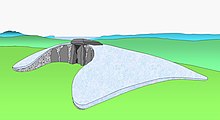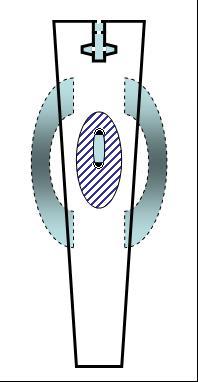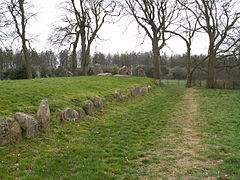Wayland's Smithy
Wayland's Smithy ( English for " Wielands forge"; also called Smitty) near Swindon or Compton Beauchamp is a barrow in Oxfordshire , the oldest expansion of which took place around 5500 years ago. It was built on a flat hill near the White Horse Hills .
Digs
The grave was opened in the 1920s, excavated by RJ C. Atkinson and Stuart Piggott from 1962 to 1963 , and re-examined by Alasdair Whittle in the 1980s .
First construction phase
The 16.5 m long oval burial mound was made of chalk that was taken from pits on site, poured out and attached to the sides with stone slabs. Inside was a wooden chamber with the remains of 15 people. The burial site is believed to have served as a place for community ceremonies and as a symbol of the group's ownership of the land.
Cotswold Severn Tomb

Around the year 3300 BC A new hill was built over the old one. This second expansion stage completely covers the first. This second expansion stage is four times longer and built in a much more precise trapezoidal shape. Again circles were piled up and the edges bordered with this time larger stone slabs. A dolmen with side chambers was built into the wider end of the hill, which was bordered by very high stone blocks . At the other end, the hill slopes gently and is bordered by small stone slabs. It is believed that this second burial site was in use for a couple of centuries. It is difficult to make a precise statement about this, since during the first excavation in 1920, only the ransacked remains of at least eight people were found in the looted grave.
Surname
The burial mound was baptized Wayland's Smithy 4,000 years after the second stage was built . The Saxons found the hill and believed it was the work of their mythical hero Wieland the Smith (Wayland the Smith). Over time, the local legend, first written down in 1738 by the archaeologist and archivist Francis Wise , developed that Wieland the blacksmith, in a kind of silent trade, replaced the horseshoes of travelers' horses when they lay a silver penny next to the burial mound. (The use of metal detectors on the premises is strictly prohibited.)
The grave is now owned and maintained by the English Heritage .
- Wayland's Smithy
See also
literature
- CR Peers, Reginald A. Smith: Wayland's Smithy, Berkshire. Antiquarian Journal 1, 1921, pp. 183-98.
- Homer Sykes: Mysterious Britain - Fact and Folklore George Weidenfeld & Nicolson Ltd. 1993 p. 25
- Alasdair Whittle: Wayland's Smithy, Oxfordshire: excavations at the Neolithic tomb in 1962-63 by RJC Atkinson and S. Piggott. Proc. Prehist. Soc. 57, 1991, pp. 61-101.
Web links
Individual evidence
- ^ Max Förster: "Stummer Handel" and Wielandsage. In: Alois Brandl, Heinrich Morf (Hrsg.): Archive for the study of modern languages and literatures . 61st year, 119th volume, George Westermann, Braunschweig 1907, pp. 303–308, here p. 305
Coordinates: 51 ° 34 ′ 0.3 " N , 1 ° 35 ′ 45.2" W.





